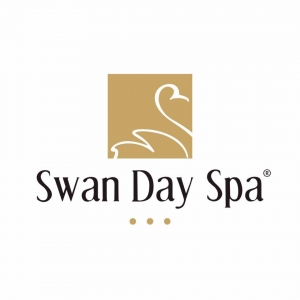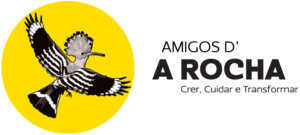
Newsletter June 2019
Welcome to our June Newsletter.
Thank you for being ‘A Friend’, we hope you enjoy this month’s articles and our new Guest Photo section.
Happy Summer 🙂
Helen & Filipa
S
N
A
P
SHOT

Riley & Barbara Massey

Age: 80 & 78
Nationality: English
Job: Both retired; Riley – I was an Instructor of large earthmoving equipment and travelled around the world with my job; Barbara – Secretary for a Travel Agency
When did you first come to A Rocha?
The first time we came to A Rocha was around 18 years ago, when Will (old scientific director of A Rocha Portugal) and Rachel Simonson were here, their young daughter (Rosie) was still a baby. We were walking down in the estuary of Ria de Alvor and we met Rachel, she told us, if we were interested in birds that we should come to A Rocha’s open day. So we did and we started coming every Thursday and became volunteers. First we helped to sort out the library, and I (Riley) used to help with the maintenance and the electric stuff. For the next few years we used to come every autumn and help on the Thursday open days, serving the coffees and welcoming the visitors.
What does A Rocha mean to you?
A Rocha is like a family, it is like a second home. It is just a peaceful place; the atmosphere and the peace you can feel here are just amazing! The people we meet, the birds, the ringing make it unique. Today (March 2019) I met this couple from Canada; along the years we made friends with people from different countries.
With all the wonderful birds here, which is your favourite?
My (Riley) favourite bird for sure is the Bee-eater, I love the sound of them! But as well, the Kingfisher and the Black Shoulder Kite. For me (Barbara) it is the Oystercatcher.
IFO’s – Identified Flying Objects…

Common Brimstone
(Gonepteryx rhamni, Linnaeus, 1758)

Morphology: It is a large butterfly from the Pieridae Family; it has a wingspan of 60 millimetres. The males have a distinctive lemon yellow colour on the upperside of wings while females have a greenish white colour; both have orange spots on each wing. It has one brood per year. It flies usually from March to August; sometimes it is possible to see it flying on sunny winter days.
Habitat: Woodland rides, clearings and edges, scrubby hillsides, suburban areas, parks, gardens and bushy grasslands. During mating they prefer wetlands.
Distribution: It is found from Western Europe to Eastern Asia and Northern Africa.
Notes: The caterpillars feed on buckthorns, plants from the Rhamnaceae Family such as Rhamnus species. The Common Brimstone has a life span of 10 months and it is one of the longest-living butterflies. It hibernates as an adult, sheltered under vegetation; can do small migrations between breeding and wintering areas. The shape and colour of its wings gives it an excellent camouflage (resembles a leaf) and the butterfly is almost invisible when at rest. According to some myths the word butterfly comes from “butter coloured fly” a world that was used to describe Brimstone by the first naturalists.
Tweet… Tweet…


Common Kingfisher
(Alcedo athis, Linnaeus, 1758)
Identification: It is a medium bird from the Order Coraciiformes. It is a colourful bird, unmistakable; the upperparts are electric blue and the chest is orange; it has a barred blue cap, the bill is long and strong. It shows sexual dimorphism, males have almost the entire bill black, while females have it almost reddish.
Habitat and Ecology: It can be found in a wide variety of habitats always close to water, freshwater or marine: streams, small rivers, canals, ditches, lakes and ponds, estuaries, harbours and rocky seashores. Feeds mainly of small fish, but can also consume aquatic insects, amphibians and crustaceans. It needs habitats with perching sites, like reeds, bushes, trees or rocky places. It nests in holes in walls, old trees or soil banks.
Distribution: Widespread in Europe, Asia and North Africa.
Threats: Least Concern in the International Union for Conservation of Nature (IUCN) red list. This species is quite sensitive to hard winters. The major threats are river pollution, canalization of streams with clearance of emergent vegetation and decline of fish population.
DID YOU KNOW?
-
A Rocha Portugal together with four other foreign organizations: Resecentrum Arvidsjaur Kommun (Sweden), Quarter Mediation (Netherlands), Università delle LiberEtà del FVG (Italy) and EK Kavalas (Greece) is part of an European project: ENTRELAB – Enhanced ENTREpreneurial attitude in adult education for a better LABour market integration. This project aims to empower trainers to create ecosystems of entrepreneurial learning for adult education. For more information visit the website: www.entrelab.eu
- On 23rd March and 26th April, A Rocha Portugal did a beach cleaning activity, as part of the Entrelab and “My beach” project, to monitor the marine litter according to OSPAR standardized methodology. Thank you to everyone who helped. In September another activity planned!
- During the school year 2018/2019 students and teachers participated in a lot of activities at A Rocha Centre and surrounding areas, watch the small video made by Isabel Soares! See the video
- On the 30th of April, a local person, brought an Eagle Owl (Bubo bubo) to Cruzinha, the bird was found in the village (Mexilhoeira Grande) with no visible injuries but in shock. The local authorities (SEPNA from GNR) were contacted and came to take the bird to RIAS, the Recovery Centre for injured birds.

-
This month the Storm Petrel Project will start again, at Cruzinha volunteers will arrive to take part in this unique experience and collect data for scientific projects (see Newsletter July 2018).
Dunes habitat
Coastal sand dunes are accumulations of windblown maritime sand which usually form behind wide, sandy beaches and which establish the transition between sea and land. They act as natural barriers protecting the land from wind and the advance of sand and sea. They are also mobile systems of constant change with the sand and vegetation as the key players in working out an equilibrium. Plant-life has an essential role in the formation of coastal dunes, interacting with the row material of sand derived from the erosion of cliffs or from sediments brought by rivers. The process of dune building begins when dry beach sands are blown by onshore winds at low tide and are caught by obstacles at the top of the beach.  Here, small piles of sand are deposited and when big enough form “embryo dunes” capable of supporting the growth of colonising plants. These pioneers have two functions in dune construction: firstly, they continue to trap passing windblown sand and in this way raise the level of the evolving dunes and secondly, the grasses bind and begin to stabilise the sand with a skeletal system of branched rhizomes and roots. The Alvor dunes form an important part of the bay of Lagos dune system, though much disturbed in recent years, many interesting plants and birds can be enjoyed! The two common plants of the embryo dunes are the Sea Rocket (Cakile maritima) and the Blue-green Sand Couch (Elymus farctus).
Here, small piles of sand are deposited and when big enough form “embryo dunes” capable of supporting the growth of colonising plants. These pioneers have two functions in dune construction: firstly, they continue to trap passing windblown sand and in this way raise the level of the evolving dunes and secondly, the grasses bind and begin to stabilise the sand with a skeletal system of branched rhizomes and roots. The Alvor dunes form an important part of the bay of Lagos dune system, though much disturbed in recent years, many interesting plants and birds can be enjoyed! The two common plants of the embryo dunes are the Sea Rocket (Cakile maritima) and the Blue-green Sand Couch (Elymus farctus).
In “Wild Flowers of the Alvor Estuary”, A Rocha Occasional Publication Number 3, Will Simonson, 1993.
The dunes ecosystems are very fragile and easily destroyed. The treading and the presence of cars or other vehicles destroys the plants and expose the sand which is easily blown by the wind consequently destroying the dunes. Some of the bird species which use the dunes for breeding, are the Kentish Plover (Charadrius alexandrinus), the Little Tern (Sternula albifrons), the Short-Toed-Lark (Calandrella brachydactyla).
POPPED UP
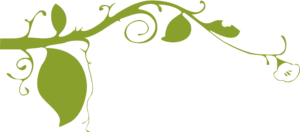

European Sea Rocket (Cakile maritima)

Identification: It is a common annual plant in the Mustard Family (Brassicaceae); it is low to short with grey-green leaves, irregularly pinnately-lobed. The flowers are violet, pink or white and it flowers from March to December. The fruits float and are water dispersed.
Habitat and distribution: Sandy coastal habitats near dunes. It is native from Western Asia and Europe and North Africa.
Notes: It is a coastal pioneer plant, present in embryo dunes. It is tolerant of salt spray and transient seawater inundation. This species was introduced in America where it is considered an invasive species.
Moths by Paula Banza
Moths and Butterflies are part of an Order of insects called Lepidoptera (from the Greek, translated as “scales on the wings” or “wings made of scales”). Moths represent around 95% of this group and are very important in nature because of their role in the food chain. Recent studies also stated the importance of Moths as pollinators.
The best way to study moths is with a moth trapp, with a mercury vapour lamp or UV light, because most species are attracted to light. The moth trap is usually placed in the Cruzinha grounds on a regularly basis.
A Rocha Portugal started to monitor Moths and Butterflies starting in 1991 until today. Records are registered on a database with more than 35,000 entries from around 600 different species. 
In 2018 there were 4812 of 328 species caught, some were captured for the first time in 2017 and have been recaptured again in 2018 (Pandesma robusta, Idaea lusohispanica and Metzeneria santolinella). The most common ones were Large Yellow Underwing (Noctua pronuba) (see Newsletter Jan 2019) and Jasmine Moth (Palpita vitrealis) (see Newsletter Nov 2018).
If you are interested in moths you can visit us on a Thursday morning and you can also read the 2018 report and previous reports on our site. (Foto by Sara Roda – Noctua pronuba)
DATES TO REMEMBER

1st of June – Children’s Day
1st June – German School (Silves) Open Day 10.00 – 15.00 Friends of A Rocha Stand
1st to 2nd June – ObservArribas Nature Festival, Miranda do Douro
5th June – International Environment Day
4th June – Friends Event Honey Farm
6th, 13th, 20th and 27th of June – Cruzinha Bird ringing display & Moth Talk (10 to 12 am)
8th & 9th June – International Fair – Fatacil Lagoa Friends of A Rocha- Stand 30 (10 am to 6 pm)
10th of June – Portugal Day (National Holiday)
13th of June – Popular Saint Day – Saint António (Lisbon holiday)
20th of June – Corpus Christi (National Holiday)
24th of June – Popular Saint Day – Saint Pedro
29th of June – Popular Saint Day – Saint João (Porto holiday)
Thank you for supporting the Friends of A Rocha Portugal

Dr Roy Rodrigues
Av. Do Brasil, Qta das Palmeiras, Lt P2, R/c A, 8500-299 Portimão
(+351) 282180683
royaldente@gmail.com

Sítio da Amoreira, Lote 12,
Alvor, 8500-045 Portimão
(+351) 282412562/ 925433047
www.transfair.com.pt

Estrada principal Quatro Estradas de Alvor, nº 30
8500 – 045 Portimão
(+351) 911597735
Closed on Tuesdays
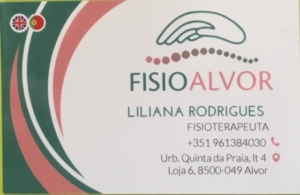
Physiotherapy, Massages (relaxation, sports, therapeutic)
Other therapies
Beauty (manicure, pedicure, hair removal, facials)
Open Monday to Friday
Unravelling the success of the Azure-winged Magpie: Success with a consequence?
A dash of blue sweeping through the sky. If you hear a call, it is likely to be followed by more dashes of blue. The Iberian Azure-winged Magpie (Cyanopica cooki) sweeps its way through the landscape of Portugal, flying from bush to bush and from tree to tree in search of food, roosting spots and conspecifics. It is a lucky bird, for its population has been increasing in numbers in Southern Portugal for the past decades, whereas most other bird species are going in the opposite direction. But what makes the Azure-winged Magpie so successful in a time where most bird species are declining? That is a question that we, Tessa (23) and Esra (18), are looking into during our stay at A Rocha Portugal in Spring 2019.  Tessa is a Master student from Wageningen University where she studies Forest and Nature Conservation. For her Master thesis she came to A Rocha to study the Iberian Azure-Winged Magpie. Esra studies Applied Biology at Aeres College Almere and has come to A Rocha for her internship to learn more about the art of doing research. We have teamed up and together we aim to unravel the success of the Azure-winged Magpie! What’s more, we will also look into the possible consequences of the Azure-winged Magpie’s success: They are clever but vicious birds that are said to steal the eggs and chicks of other birds. An increase in Azure-winged Magpie could thus have grave consequences for the other bird species of the Algarve if the magpie population continues to increase, although this rumour requires proper investigation first.
Tessa is a Master student from Wageningen University where she studies Forest and Nature Conservation. For her Master thesis she came to A Rocha to study the Iberian Azure-Winged Magpie. Esra studies Applied Biology at Aeres College Almere and has come to A Rocha for her internship to learn more about the art of doing research. We have teamed up and together we aim to unravel the success of the Azure-winged Magpie! What’s more, we will also look into the possible consequences of the Azure-winged Magpie’s success: They are clever but vicious birds that are said to steal the eggs and chicks of other birds. An increase in Azure-winged Magpie could thus have grave consequences for the other bird species of the Algarve if the magpie population continues to increase, although this rumour requires proper investigation first.
At the time of writing this, it is the start of April and our research has been going on for 6 weeks. We have tried 2 different fieldwork methods: Point counts and line transects. We started doing point counts in different habitat types as Tessa hypothesized that the Azure-winged Magpie might have been so successful due to a change in the landscape in the past decades. For example, they might be profiting from the various plantations in the Algarve, or they may have moved to different locations due to an increase in eucalyptus forest. As such, we set out to do a 150 random point counts spread across our study area, only to put a halt to this method after 54 point counts visited. As it turned out, the magpie couldn’t be found anywhere in the field no matter which habitat type we went to, yet as soon as we came home to A Rocha we would hear them screeching in the garden, as if they were laughing at us! “Why are you going through all that effort, making your way through hills and forests, shrublands and thorns, the scorching sun on a desolate land, when we are right here where the people are?”. As it turned out, we rarely saw any magpie because they simply weren’t out there in the wild where we were looking for them. Instead, we saw them near all the towns we crossed and the gardens we cycled past, conveniently close to human settlements. And thus, two weeks ago, we changed our method to cycling line transects. Each transect starts in the centre of a town and follows the road until we end up in an area where not a single house is left in sight. Every 200 meter we record the number of magpie, the habitat type(s), and the ratio of urban: green areas.  As we heard stories of Azure-winged Magpie stealing the food of people’s cats and dogs, we even decided to record the presence of dogs and cats as well. Thanks to our new method, we have seen over 400 magpies in just 2 weeks compared to just 40 in the weeks before! Our research is still in progress and soon we’ll move on to observations, but our data is already starting to show a very interesting pattern. We’ll tell you more about our findings in the next update, but we can share one secret with you that the data told us: What the Azure-winged Magpie said is true, they truly are where the people are!
As we heard stories of Azure-winged Magpie stealing the food of people’s cats and dogs, we even decided to record the presence of dogs and cats as well. Thanks to our new method, we have seen over 400 magpies in just 2 weeks compared to just 40 in the weeks before! Our research is still in progress and soon we’ll move on to observations, but our data is already starting to show a very interesting pattern. We’ll tell you more about our findings in the next update, but we can share one secret with you that the data told us: What the Azure-winged Magpie said is true, they truly are where the people are!
Written by Tessa (to be continued…)
NEW!!! 
Monthly Guest Photo
Do you have an unusual photo of an insect, flower, bird or animal which you have taken in Portugal. We would like ‘Friends’ to share these with us, each month we will choose one to publish and of course will name the photographer. Please send information on where the photo was taken.
Our first contributor is: Ros Duffell
Photo taken : Sítio das Fontes, Estômbar
Subject : Spanish Festoon (for more information see Newsletter February 2019)

Thanks Ros
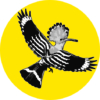 Friends Events Update
Friends Events Update
Due to requests from Friends, for family and other visitors to be able to attend our Friends Events, we are happy to announce that Friends when purchasing tickets for Events will now be able to buy tickets for non-Friends at an additional cost.
We would like to ask you if there is something that you would like to do or a place that you would like to visit, please let us know and we will look into it, and see if we can make it happen.
Helen Rodda
Two Portuguese sayings
Calm June, beautiful year.
Rainy June, dangerous year.


Sagres’ birdwatching festival returns 10-13 October
In October, thousands of birds fly over the Algarve, en route to wintering grounds in Africa. Join the birdwatchers who flock to the region, and make the most of this incredible sight with four days jam-packed with activities.  From birdwatching tours on land and sea to hikes along scenic trails, there are plenty of opportunities for nature lovers to discover there’s more to the Algarve than beaches. And there’s plenty for birdwatchers’ families, too, from whale- and dolphin-spotting trips to handicraft stalls and children’s activities.
From birdwatching tours on land and sea to hikes along scenic trails, there are plenty of opportunities for nature lovers to discover there’s more to the Algarve than beaches. And there’s plenty for birdwatchers’ families, too, from whale- and dolphin-spotting trips to handicraft stalls and children’s activities.
More information and registration at: www.birdwatchingsagres.com/en

Check the website for dates for organised tours
Birds of North Tunisia – part I
Over the last 12 months, I have travelled several times to Tunisia for fieldwork related to wind farms. This allowed me to do quite a lot of birdwatching in the north and south of the country.
My first Tunisian birds were seen from the hotel window. A Common Bulbul (Pycnonotus barbatus) woke me up singing in the morning. Spotless Starling (Sturnus unicolor), Spanish Sparrow (Passer hispaniolensis) and Laughing Doves (Streptopelia senegalensis) were also common. A visit to one of the parks in the city, allowed us to see North African Blue Tit (Cyanistes teneriffae) and Spotted Flycatcher (Muscicapa striata).
Near Tunis, the Lac Sud area is worth a visit. Slender-billed Gulls (Chroicocephalus genei) and Common Terns (Sterna hirundo) are present in spring, with Flamingos (Phoenicopterus roseus).  During our visit, we had the chance of seeing a Montagu’s Harrier (Circus pygargus) on migration. Waders can be abundant: Redshanks (Tringa totanus), Greenshanks (Tringa nebularia), Grey Plovers (Pluvialis squatarola), Black-winged Stilts (Himantopus himantopus), Kentish (Charadrius alexandrinus) and Ringed Plovers (Charadrius hiaticula). Stone Curlews (Burhinus oedicnemus) seem to like the area as many can be seen. They share the area with Barbary Partridges (Alectoris barbara).
During our visit, we had the chance of seeing a Montagu’s Harrier (Circus pygargus) on migration. Waders can be abundant: Redshanks (Tringa totanus), Greenshanks (Tringa nebularia), Grey Plovers (Pluvialis squatarola), Black-winged Stilts (Himantopus himantopus), Kentish (Charadrius alexandrinus) and Ringed Plovers (Charadrius hiaticula). Stone Curlews (Burhinus oedicnemus) seem to like the area as many can be seen. They share the area with Barbary Partridges (Alectoris barbara).
Going North-east from Tunis, the Cap Bon area is a great place for birds of prey. They use the area to pass to Sicily and then Italy during spring migration and also during the autumn.  The best place to see them is probably El Haouaria. Fieldwork done in September in an area nearby allowed us to see many Marsh Harrier (Circus aeruginosus) and Honey Buzzards (Pernis apivorus) going south.
The best place to see them is probably El Haouaria. Fieldwork done in September in an area nearby allowed us to see many Marsh Harrier (Circus aeruginosus) and Honey Buzzards (Pernis apivorus) going south.

Roger McIlroy
Grasshopper
Order Orthoptera
Fam Acrididae
Species:
White-banded grasshopper Eyprepocnemis Plorans
Pincer grasshopper Calliptamus sp.
Description
Grasshoppers are insects that are part of the order Orthoptera. Like all insects it has six legs, a head with antennae, thorax, and abdomen. It also has an exoskeleton which is a hard outer surface that protects its softer insides. Grasshoppers have two pairs of wings. The back wings are larger while the front wings are small and fairly hard. Their back legs are very large to allow them to be powerful jumpers.
The White Banded Grasshopper is generally brown in colour, with striped eyes, a white/yellow band on its wing and a white/yellow band on its leg. The stridulation pegs are yellow with black tips.

White-banded grasshopper Eyprepocnemis plorans (RM)

Calliptamus sp (RM)
The Pincer Grasshopper is grey in colour with black blotches on its wing and leg. The type of Calliptamus can’t be determined from the photograph.
Distribution
They grasshoppers have similar ranges, occurring in southern parts of Portugal and Spain, Italy and Greece, Africa, as well as parts of Western Asia.
Habitat
The White Banded Grasshopper usually inhabits wetlands like reed belts, ruderal (disturbed ground) vegetation, salt marshes, riverside strips, ditches, seldom mown grasslands etc., especially in low and hot regions, often along the coast. The one pictured was encountered at the lower part of the dyke (hence the barnacles) protecting the Alvor estuary fresh water lagoons from the sea.
The Pincer Grasshoppers in contrast thrive in warm dry habitats with sparse vegetation cover such as grasslands and rocky steppes, old quarries, gravel pits, rock-strewn areas beside rivers, sand dunes and fallow land. This was found on the limestone pavement topography on the coastal path between Carvoeiro and Ferragudo.
Notes To jump, the grasshopper’s hind legs act like miniature catapults. When it bends its legs at the knee, a mechanism within the knee works like a spring, storing up energy. When the grasshopper is ready to jump, it relaxes the leg muscles, allowing the spring to release flinging it into the air. When in the air, it opens its wings often with a flash of colour, and flies off for a short distance. When they land they will depend on their camouflage to hide, but with a bit of luck they can be found, and photographed.
The are famous for their chirping sound (called stridulation) made by males to attract mates, which they do by rubbing a series of pegs on their hind legs against their front wings, much like a violinist rubbing the bow against their violin strings.
Grasshoppers have two antennae which they use to smell and sense humidity, and small pinchers to tear off food such as grasses, leaves and unfortunately for farmers, cereal crops. They can eat half its body weight in vegetation each day, and have being doing so for a long time, as they are one of the most ancient living group of chewing herbivorous insects, dating back around 250 million years! A problem arises however if there are too many grasshoppers trying to feed on a limited food supply. If this happens they can transform into locusts and form swarms seeking out greenery to feed upon. Large swarms become plagues that can devastate crops.
If you have any queries please do not hesitate to contact us:
friends.arpt@arocha.org
Our office is open from Monday to Wednesday from 9:00 to 12:00 am
Or visit us on our open day: Thursdays from 10:15 to 12:00 am
See map: https://arocha.pt/en/contact-us/
GPS coordinates
37°08’39.8″N (37.1444) 8°36’29.2″W (-8.6081)
(+351) 282 968 380
Thank you for supporting us!
Hope to see you soon!

